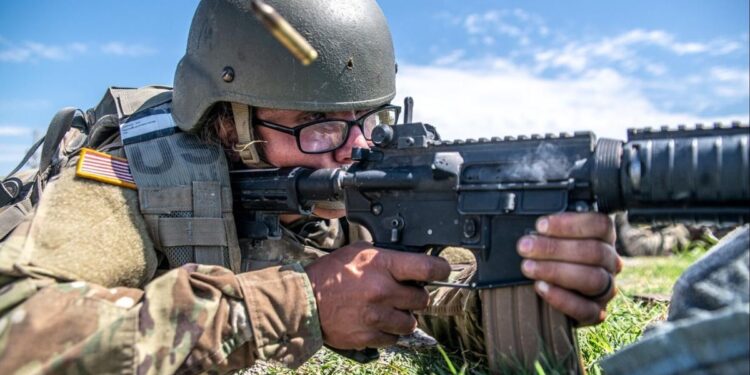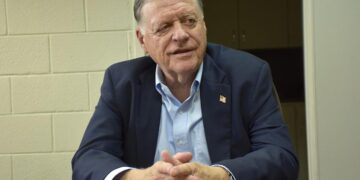This year, the U.S. Army’s Training and Doctrine Command celebrates a landmark event — its’ 50th anniversary. As it stands at the helm of shaping the Army’s future, the spotlight falls on Fort Sill, a key player in TRADOC’s mission and a driving force behind the Army 2030 modernization strategy.
On July 1, 1973, right by the Chesapeake Bay’s Hampton Roads and just outside the stone walls of old Fort Monroe in Virginia, the Army established the U.S. Army Training and Doctrine Command under its first commander, Gen. William E. DePuy. As Fort Sill celebrates TRADOC’s 50th anniversary, the question arises, why did the Army establish TRADOC?
Understanding the answer to this question means delving into the archives of the Army’s past, dating back several decades. Throughout and following the Second World War, the Army initiated numerous structural reshuffles, seeking a balance between sustaining readiness among both active and reserve units and fulfilling their training and educational duties. These continuous efforts gave rise to institutional entities such as the wartime General Headquarters, U.S. Army and the Army Ground Forces, as well as the postwar Office of the Chief of Army Field Forces. In 1955, a further restructuring effort amalgamated nearly all the service’s activities based in the U.S. into the Continental Army Command. This entity persisted throughout the Vietnam War, once again illustrating the unwieldiness of an overly centralized command bearing too many institutional responsibilities and mission activities, said Lt. Col. Daniel Threlkeld, Commanders Planning Group director.
In the late 1960s, the Army embarked on another round of organizational reform, picking up where unfinished initiatives from earlier in the decade had left off and continuing until the U.S. military’s withdrawal from Vietnam in the spring of 1973, said Threlkeld. This iteration of restructuring aimed to alleviate the overstretched span of control within the Continental Army Command CONARC by once again seeking an institutional equilibrium between the readiness of U.S.-based units and their training and education responsibilities. This undertaking, eventually dubbed Operation STEADFAST, reached a pivotal moment on July 1, 1973, when the Army formally dissolved CONARC. In its place, two new entities arose: the Training and Doctrine Command TRADOC and the U.S. Army Forces Command. In a simultaneous move, the Army disbanded the Combat Developments Command, integrating its mission into the newly formed TRADOC.
Since that time, the U.S. Army Forces Command has been tasked with managing active duty and reserve units and preparing them for warfare through collective training. Meanwhile, TRADOC has been responsible for inducting the Army’s Soldiers and their leaders into service, providing individual training and education, defining fighting doctrine, designing the units they serve in and — until the U.S. Army Futures Command was established in 2018 — outlining the specifications for the equipment used by all Soldiers in their tactical and operational endeavors. Additionally, until the U.S. Army Installation Management Command was fully established in 2006, TRADOC also oversaw the operation of the Army’s posts, camps, and stations where the command’s duties were carried out.
“Over the past five decades, TRADOC has been the cornerstone of recruiting, training, and educating the Army’s fighting force, preparing them to safeguard our nation’s freedom,” said Threlkeld. “As we celebrate TRADOC’s golden jubilee, we must acknowledge the significant role played by Fort Sill in achieving this mission.”
Known for its innovation and excellence, Fort Sill houses the Fires Center of Excellence. The center has been a pioneer in implementing the Army Learning Model, using advanced technology and simulations to train Field Artillery and Air Defense Artillery Soldiers and officers.
“Fort Sill’s innovative approach to training, which leverages cutting-edge technology, is not only cost-effective but also augments learning outcomes significantly,” Threlkeld noted. “As the security environment becomes increasingly complex, such forward-thinking initiatives are key to preparing our Army for the future.”
As the Army marches toward its 2030 modernization goals, Fort Sill’s contribution has been instrumental. The training provided at Fort Sill is vital in tackling modern challenges, such as those posed by unmanned aerial vehicles, said Threlkeld.
“Fort Sill’s comprehensive training programs have been central to maintaining our military’s edge, ensuring that our commanders can count on timely and accurate Fires, a fundamental aspect of military operations,” Threlkeld.added.
Threlkeld also highlighted the dedication and professionalism of the personnel at Fort Sill. “From the drill sergeants to the Advanced Individual Training platoon sergeants, the commitment to learning and excellence at Fort Sill is truly inspiring. These professionals have been pivotal in achieving the Army’s training goals.”
Threlkeld. extended his congratulations to TRADOC and Fort Sill.
“On this momentous occasion, I extend my heartfelt congratulations to TRADOC for 50 years of unmatched commitment to the U.S. Army. I also applaud Fort Sill for its substantial contributions to TRADOC’s mission and the Army 2030 Modernization. Here’s to another 50 years of shaping the future of our Army.”
As TRADOC celebrates half a century of achievements, Fort Sill stands as a beacon of TRADOC’s mission in action, ready to lead the way toward Army 2030. The next 50 years promise to be just as dynamic and transformative as the first said Threlkeld.
Want to reach a local audience and grow your business?
Our website is the perfect platform to connect with engaged readers in your local area.
Whether you're looking for banner ads, sponsored content, or custom promotions, we can tailor a package to meet your needs.
Contact us today to learn more about advertising opportunities!
CONTACT US NOW






